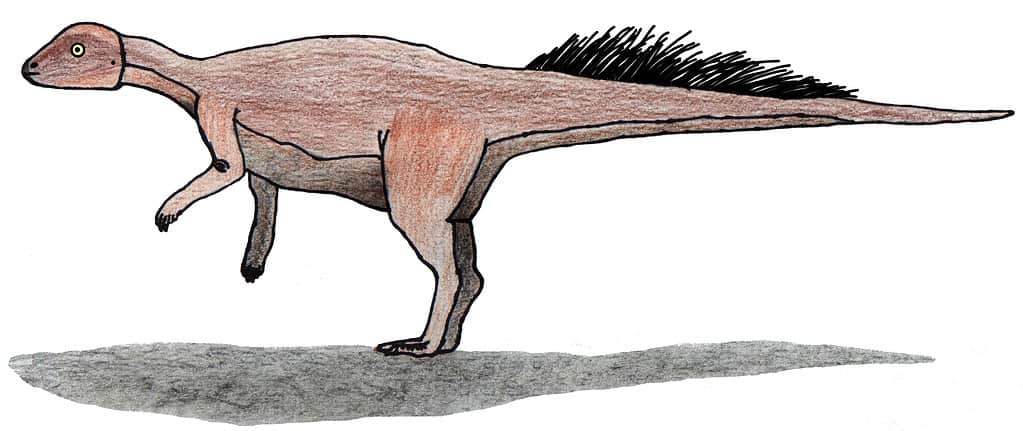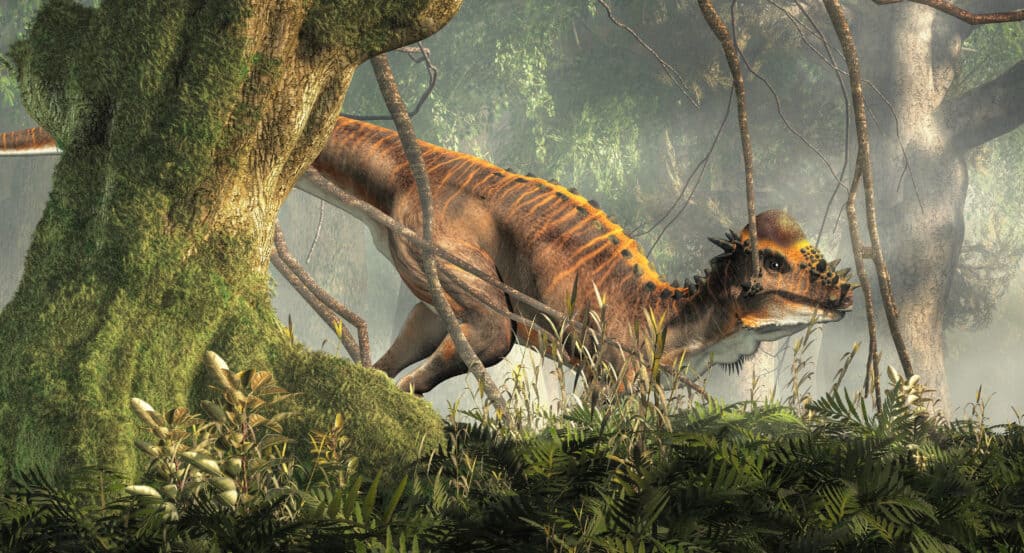Scientific names are always a mouthful, but some are really exceptional. Take Micropachycephalosaurus, for example! Micropachycephalosaurus is the dinosaur with the longest name. When you break down the constituent syllables, it all makes sense, but just looking at the word is enough to make your head spin. Let’s delve a little more into the Micropachycephalosaurus to find out what it looked like, what it ate, and how long ago it walked Earth.
How Do You Pronounce Micropachycephalosaurus?
Take a deep breath!
The dinosaur with the longest name takes some pronouncing. Twenty-three letters form nine syllables. You can break the word down like this:
- Micro
- Pachy
- Cephalo
- Saurus
String them together, and you have:
mike-row-pak-ee-keff-ah-loh-sore-us
Its name means small, thick-headed lizard, but that is not an insult. Thick-headed refers to the thickness of its skull roof, not its brain capacity. That said, experts have no idea if Micropachycephalosaurus was a brainy Einstein dinosaur or a bit slow on the uptake.
Micropachycephalosaurus Fossil Remains
Only one Micropachycephalosaurus fossil is available.
It dates from the late Cretaceous, which was around 101-66 million years ago, and when this long-named dinosaur species was roaming the ancient world.
The first fossilized remains, the holotype, were discovered on a cliff in the Liaoyang province of China near the Hongtuyan train station. Palaeontologist Dong Zhiming examined the fossils and named them. All that remained were the left body, a partial row of teeth, vertebrae, and other sections of bone.
All About Micropachycephalosaurus
It’s difficult to piece together the lifestyle and appearance of Micropachycephalosaurus because only one fossil has ever been found. Here’s what paleontologists know so far.

Fossilized remains of
Micropachycephalosauruswere discovered embedded in a cliff in the Liaoyang province of China.
©Ghedoghedo, CC BY-SA 4.0, via Wikimedia Commons – License
Micropachycephalosaurus: Classification
Micropachycephalosaurus hongtuyanensis is the type species. There are no other species in its genus classification.
Micropachycephalosaurus was classed as a pachycephalosaur in the early days. Still, modern investigation has unearthed no evidence that it had a thick skull roof, which is one of the main reasons Dong Zhiming first classified it under pachycephalosaur in 1978.
In 2008, Butler and Zhao, two respected paleontologists, could not find anything to suggest Micropachycephalosaurus was a pachycephalosaur. The key piece of evidence linking our long-named dinosaur with dome-headed pachycephalosaurs was its thickened skull roof, and that piece is missing. Due to the missing evidence, Butler and Zhao classified it as cerapoda, but in 2011, analysis showed it was actually a member of the Ceratopsian family along with the famous triceratops.
The two have a bird-hipped ancestor. Therefore, the new classification isn’t that dissimilar from Dong’s initial classification.
Micropachycephalosaurus: Appearance
Despite being the dinosaur with the longest name, Micropachycephalosaurus is very small!
They were, on average, 2.5 feet long, stood two feet tall, and weighed 5–10 pounds. For comparison, that’s the same size as a large chicken but weightier.
Micropachycephalosaurus was a bipedal dinosaur that walked on two back legs. Bipedal dinosaurs had legs that were much stronger than their shorter front limbs. They used them to run fast, either to hunt, like Tyrannosaurus rex or escape, which is what experts think Micropachycephalosaurus needed long legs for.

was a bipedal dinosaur that walked on two back legs.
©IJReid, CC BY-SA 3.0, via Wikimedia Commons – License
Where Did the Dinosaur with the Longest Name Live?
Micropachycephalosaurus lived in modern-day Asia in the late Cretaceous Period around 69 million years ago. Modern-day Shandong was a warm, humid fluvial and lacustrine environment during the Cretaceous Period, meaning a high amount of water had shaped the landscape. Ankylosaurs, hadrosaurs, and many sauropod species roamed the area. Fossilized eggs have been discovered there numerous times.
What Did Micropachycephalosaurus Eat?
The dinosaur with the longest name was a herbivore. It chiefly ate plants, including ferns, cycads, conifers, and the flowering plants that began to emerge at this point in history, including magnolias, figs, willows, and sycamores.
Some experts suggest that as well as plants, these herbivores would have been opportunistic, like modern chickens, and supplemented their diet with insects, small lizards, and mammals.
Reproduction
The longest-named but small-sized dinosaur reproduced by laying eggs. Females are likely to have found a safe spot to lay eggs and either incubated or left them in a warm, humid environment to hatch out.
No one knows if parents cared for youngsters like modern-day birds or left them to fend for themselves like modern-day lizards.
4 Other Dinosaurs With Long Names
Micropachycephalosaurus is the longest generic dinosaur name with 23 letters, but there are other long-named dinosaurs hot on its heels.
Carcharodontosaurus (19 letters)
165 million years ago, in the Late Cretaceous era, Carcharodontosaurus (car-car-o-don-toe-sore-us), the “shark tooth lizard,” roamed modern-day North Africa. It was a large dinosaur well worthy of its long name. Its skull alone measured up to 5.3 feet long and contained eight-inch-long serrated teeth! Overall, this massive carnivore was 33 feet long and weighed four tons.
One study showed that Carcharodontosaurus could lift 935 pounds in its massive jaws. That’s the equivalent of a grand piano. Incredible.
Archaeornithomimus (18 letters)
Archaeornithomimus (Ark-ee-orn-ith-oh-meem-us) lived 80 million years ago in Asia in the late Cretaceous Period, roughly the same time as our Micropachycephalosaurus.
A medium-sized omnivorous ornithomimosaur from modern-day Mongolia, it weighed 200 pounds and reached 11 feet long. It chiefly ate plants, fruit, greenery, eggs, and meat.
Its long name means “ancient bird mimic,” and there’s some evidence it may have grown feathers alongside a horny keratinous beak, hence its name.
Eustreptospondylus (18 letters)
Theropod Eustreptospondylus (ewe-strep-toe-spon-die-luss) lived in modern-day England in the Middle Jurassic era. It was 15 feet long and weighed around 1,000 pounds. Small mammals and other dinosaurs were this carnivore’s prey. Eustreptospondylus looked a little like T.rex with large bipedal legs and tiny forearms.
Its skeleton is very distinctly curved. As a result, its name means “well-curved vertebrae.”
Pachycephalosaurus (18 letters)
Pachycephalosaurus was a boneheaded herbivore that roamed North America in the Late Cretaceous Period. Only the skull has ever been found, but paleontologists estimate Pachycephalosaurus was nearly 15 feet long and weighed up to 990 pounds, so it fully deserves its long name. It had tiny teeth, horns on the back of its skull, and a head covered in a thick layer of bone up to 10 inches thick! Early paleontologists thought the thick skull bone was dinosaur kneecaps.
Its diet is a mystery, but experts think it may have been an omnivore.

was a boneheaded herbivore nearly 15 feet long and weighing up to 990 pounds.
©Daniel Eskridge/Shutterstock.com
What’s the Shortest Dinosaur Name?
At the opposite end of the scale, we have the shortest dinosaur name. It’s Mei, just three letters compared to Micropachycephalosaurus, the longest dinosaur name.
Mei was a basal troodontid that lived in the Liaoning area of China during the early Aptian Cretaceous Period 125.8 million years ago.
Its name means “sleepy” because the holotype fossil was discovered curled in a roosting bird-like posture with its snout tucked under its legs. Paleontologists think the unfortunate dinosaur was covered in ash after dying from carbon monoxide poisoning from nearby volcanoes.
The surrounding area was covered with active volcanoes, coniferous forests, ferns, and horsetail, and many bird-like dinosaurs were living side-by-side. Mei was most likely a carnivore that preyed on lizards, insects, and small mammals. It had long legs and a long neck and was duck-sized, so it was quite similar to Micropachycephalosaurus.

The fossil that was discovered showed the
Meidinosaur curled in a roosting bird-like posture with its snout tucked under its legs.
©Bruce McAdam, CC BY-SA 2.0, via Wikimedia Commons – License
The Longest Dinosaur Name: Micropachycephalosaurus
Micropachycephalosaurus is the longest dinosaur name, but conversely, it’s one of the smallest dinosaurs ever uncovered.
In the 1970s, its fossilized remains were found in Shandong, China, where they had laid since the late Cretaceous Period. Micropachycephalosaurus was a chicken-sized herbivore that was most likely fast on its feet.
It’s currently the longest dinosaur name ever, but that may change in the future because paleontologists frequently discover new species, such as the 2022 discovery of the carnivore Guemesia ochoai.
Who knows, 25-letter Chonkytexanheckosaurusboi (chonky texan heck o saurus boy) might be the longest dinosaur name sometime in the future!
The photo featured at the top of this post is © Catmando/Shutterstock.com
Thank you for reading! Have some feedback for us? Contact the AZ Animals editorial team.






